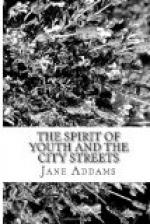An investigation showed that cocaine had first been offered to these boys on the street by a colored man, an agent of a drug store, who had given them samples and urged them to try it. In three or four months they had become hopelessly addicted to its use, and at the end of six months, when they were brought to Hull-House, they were all in a critical condition. At that time not one of them was either going to school or working. They stole from their parents, “swiped junk,” pawned their clothes and shoes,—did any desperate thing to “get the dope,” as they called it.
Of course they continually required more, and had spent as much as eight dollars a night for cocaine, which they used to “share and share alike.” It sounds like a large amount, but it really meant only four doses each during the night, as at that time they were taking twenty-five cents’ worth at once if they could possibly secure it. The boys would tell nothing for three or four days after they were discovered, in spite of the united efforts of their families, the police, and the residents of Hull-House. But finally the superior boy of the gang, the manliest and the least debauched, told his tale, and the others followed in quick succession. They were willing to go somewhere to be helped, and were even eager if they could go together, and finally seven of them were sent to the Presbyterian Hospital for four weeks’ treatment and afterwards all went to the country together for six weeks more. The emaciated child gained twenty pounds during his sojourn in the hospital, the head of which testified that at least three of the boys could have stood but little more of the irregular living and doping. At the present moment they are all, save one, doing well, although they were rescued so late that they seemed to have but little chance. One is still struggling with the appetite on an Iowa farm and dares not trust himself in the city because he knows too well how cocaine may be procured in spite of better legislation. It is doubtful whether these boys could ever have been pulled through unless they had been allowed to keep together through the hospital and convalescing period,—unless we had been able to utilize the gang spirit and to turn its collective force towards overcoming the desire for the drug.
The desire to dream and see visions also plays an important part with the boys who habitually use cocaine. I recall a small hut used by boys for this purpose. They washed dishes in a neighboring restaurant and as soon as they had earned a few cents they invested in cocaine which they kept pinned underneath their suspenders. When they had accumulated enough for a real debauch they went to this hut and for several days were dead to the outside world. One boy told me that in his dreams he saw large rooms paved with gold and silver money, the walls papered with greenbacks, and that he took away in buckets all that he could carry.




